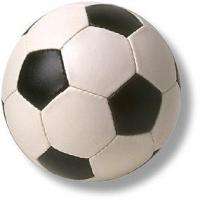Physics can improve your football

As the World Cup draws closer and football fever starts to take over, physicist Nick Linthorne has found out how players like Gary Neville can achieve the perfect long throw-in, which could be crucial in setting up a goal for the England squad. An article, A new angle on throwing, in the June edition of Physics World, describes how the physics of projectiles can be used to calculate the optimum angle at which a ball needs to be released to achieve the longest possible throw-in. The article describes how the optimum angle is much less than physicists previously believed.
When a player takes a long throw-in, they want the ball to travel as far as possible. The distance a ball travels when it is thrown depends on both the speed at which it is released and the launch angle. According to the laws of basic physics, a simple projectile will travel furthest when launched at an angle of 45 degrees.
However, this approach assumes that the launch speed is independent of the launch angle. New research, however, has found out that this is not true in practice, as when most footballers take a throw-in they use shallower angles nearer 30 degrees. This is because the muscles in a player’s arms and back allow more horizontal than vertical force to be exerted on the ball when it is released.
Dr Nick Linthorne, a physics lecturer and researcher at Brunel University, and his student David Everett came to this conclusion after taking video footage of two players performing throw-ins at a variety of angles. They then used computer software to measure the different ball speeds and angles in the video.
Dr Linthorne said “To calculate the optimum angle at which to launch the ball, we first derived an expression from the video data, linking the release speed to the release angle. This expression for release speed was then substituted into the physics equation for the range of a projectile. By plotting a graph for the range versus several angles, we were able to calculate the optimum angle of release to be 30 degrees. Of course the angle will vary for each player, as they have different strengths, but for most players the optimum launch angle is calculated to be between 25 and 30 degrees, which agrees with what we see from players on the pitch.”
How far a ball travels when a player takes a throw-in depends on other factors such as the player’s limb lengths and muscle strengths and most players use trial and error to work out the best angle for them. This formula explains the physics behind what they practise and why it works. No doubt there will be many other moves seen on the pitch this summer such as curving free kicks that can also be explained by physics.
Source: Institute of Physics




















